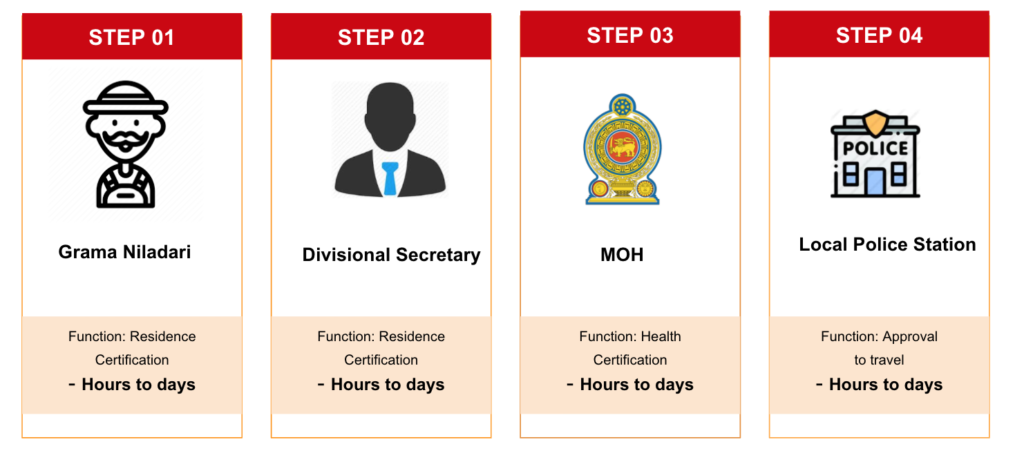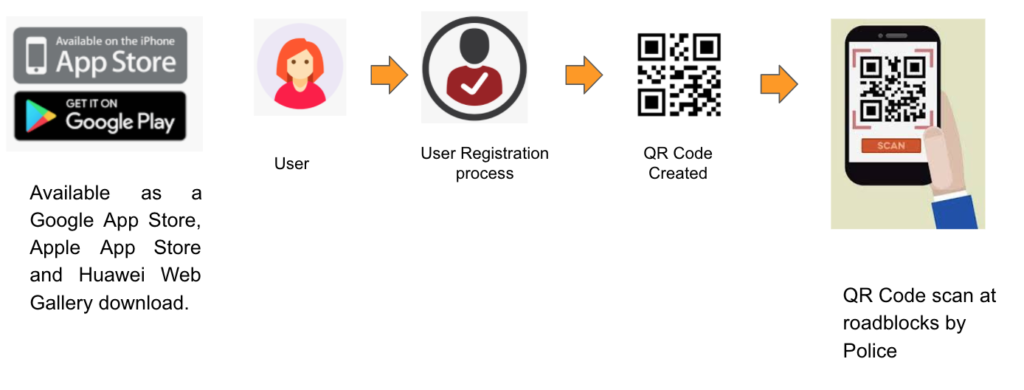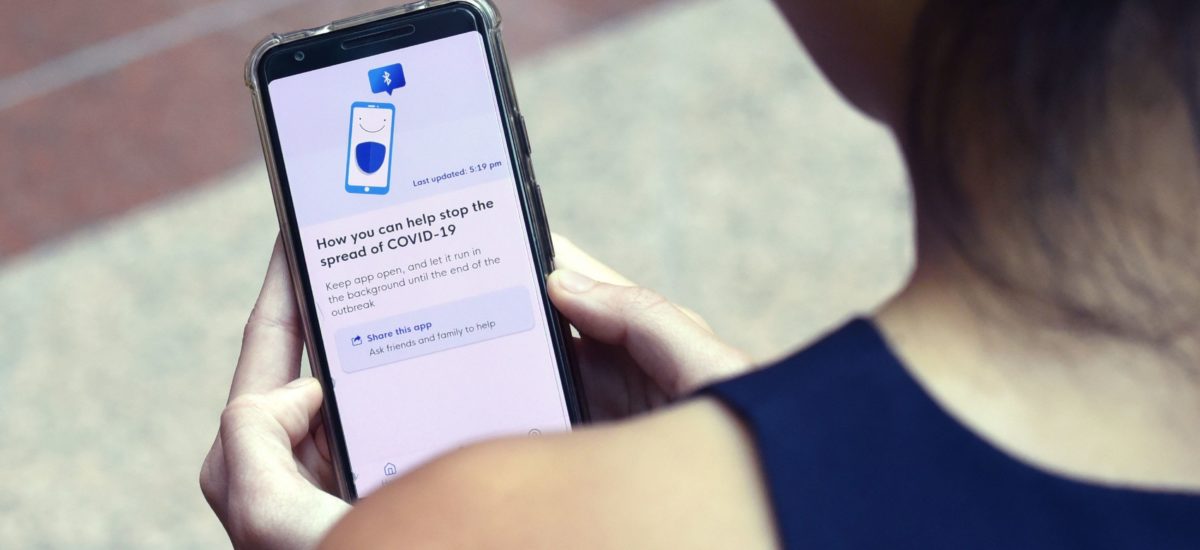Photo by Catherine Lai, AFP via Getty Images, courtesy CNBC
More than half a century ago, mankind placed a man on the moon, using giant Saturn-V rockets to propel spaceships. If we were to go back there now, we would undoubtedly use far more modern technology, safer, more efficient and with a much higher likelihood of success. The war against COVID is no different; we need to use our latest technological weapons and strategies. But too many countries, Sri Lanka included, are clinging to the ancient ways.
Obsolete Methods and Technology
In comparison with the rest of the world, Sri Lanka has done quite well in limiting the spread of the COVID-19 virus. The number of known cases, and the number of deaths, is quite insignificant when one compares with global numbers. Much of the credit for this achievement can go to an unusual source – the country’s intelligence services – which dived in to take on a challenge that they were not accustomed to. The manner in which the half a dozen clusters have been contained and the contact tracing carried out, has been quite amazing.
However, it is also quite clear that Sri Lanka has been fighting to contain COVID without employing the full power of existing technology, and thus the task has been harder than it perhaps should have been for our intelligence and health services. This is not a criticism of the efforts so far, but rather an effort to bring to the attention of those directing the anti-pandemic efforts that there are weapons that could be used and should be used. The many thousands of remarkably courageous persons who have been battling the tide of COVID have been doing so with one hand tied behind their backs, and the sooner that all available technology is brought to bear, the easier and more successful we shall be.
Contact Tracing through Apps
Firstly, it has been difficult to immediately trace who a COVID positive person has been in contact with, since the virus has a gestation period of up to four weeks, and an infected person could have come in contact with thousands of persons during that time. Entire neighbourhoods of people have been sent to quarantine, but there is always the likelihood that a few have escaped the net and spread the diseases.
In this regard, several contact tracing Apps have been developed within the last two months, in several countries. Google and Apple have joined together to provide one such App that works on both Android and iOS platforms. Australia, Singapore, China, Colombia, Czech Republic, Ghana, Israel, Malaysia, and North Macedonia have already either developed their own Apps or improved on Apps of other nations. Many other countries are now in the process of deploying similar Apps. Of course, these Apps were not in existence in the early days of the pandemic, but they are available now, and the end of the anti-COVID effort is still a long way off. With the curfew being lifted in almost the entire country and people moving around, it is even more vital to use such technology.
Uptodate Information Dashboards for Policymakers
The first several weeks of the curfew were quite chaotic due to a lack of uptodate information that technology could easily have provided. For example, distribution of adequate numbers of Personal Protective Equipment, which are locally produced in abundant numbers, to frontline persons such as personnel of the military, police, PHIs, Grama Niladaris, Divisional Secretariat staff, hospital staff, etc, was inadequate.
Authorities also took much time to come to grips with the very large migratory population in the Western Province, with tens of thousands from other provinces being stranded by the curfew. The arrests of more than 51,000 ‘curfew violators’ provides ample testimony to the fact that thousands had little choice but to break curfew rules. However, the existence of such populations is the sort of information that technology can easily provide.
Take for example the CEO of a major blue chip company in Sri Lanka. He/she would have on his phone a ‘Dashboard’ that provides real-time information of not just financial figures, but the progress of every project in the company. By linking to the HR system, he/she could access details of which employees are on leave. So too stocks of raw materials; state of individual vehicles in the transport fleet; marketing and sales figures, etc. This is the sort of dashboard that technology could and should provide about the country to the President, Prime Minister, Head of the COVID Task Force and others.
If you think this information doesn’t exist, just take a look at your National ID Card or Driver’s License. Notice the magnetic strip on the back? That can store information about each person. The first magnetic strips appeared on Sri Lankan Drivers Licenses a quarter century ago, but they have never been used. We’ve paid billions to have such smart technology, but we have almost never used it. We do see it working on our passports when we have immigration officials at BIA or foreign airports simply swiping our passports and pulling up all our details. There’s also the lists of voters that are updated on an annual basis by the Department of Elections, which we know is fully automated since you can check your voter registration online.
Rapid Dissemination of Messages to the Public
The dissemination of information to the public is a cornerstone of any effort in a public emergency. However, the government has yet to utilise the more than 31 million mobile phones in operation in this country to directly pass on messages. Instead, media releases and media conferences have been the pathway used, which are time consuming and not always accurate. The government’s efforts at transparency could be better served by direct text messaging, rather than having rumours abound. The actual content of the message relayed to the public is being decided by private texting services, TV stations, social media pundits, and village gossips.
The Sri Lankan Mobile Ecosystem, which is based on a competitive mobile network market, is robust and well established with the development of 3G and 4G connectivity in urban and semi-urban areas, more than sufficient for texting.
| Total population | Mobile subscriptions | Internet users | Active social media users |
| 21.37 Million |
31.80 Million |
10.10 Million |
6.4 Million |
| Urbanisation | vs. Population | Penetration | Penetration |
| 18% | 149% | 47% | 30% |
Authorities have also tried to use social media to disseminate information. But Sri Lanka has a relatively low level of ICT penetration. Although mobile usage far exceeds the population numbers, only 47% of Sri Lanka’s population is active online and 30% active on social media. Despite an overall literacy rate of 92% in 2019, Sri Lanka’s overall computer literacy reported for 2019 was 30.1%. While the urban sector showed the highest computer literacy rate of 41.5%, the rate for Rural and Estate sectors were 28.6 percent and 13.7 percent respectively, according to an annual bulletin on Computer Literacy Statistics – 2019, by Department of Census and Statistics Sri Lanka.
Validation of Existing Information
The issuing of curfew passes has been another problematic area that needlessly places the lives of police, medical workers and local government officials at risk. At present, this requires a 4-step process of a letter being certified by one’s Grama Niladari, Divisional Secretary, MOHz, and local Police Station, which leads to hundreds of people crowding outside these offices every day.

However, the first two steps are simply for validation of residency, which could be done through one’s NIC, since an NIC application has to go through the GN and DS. There are those who would have moved residence, but the GN and DS would only have to deal with this smaller number. In addition, an online or mobile phone based system could easily introduce an appointment system to visit the MOH and Police, which would eliminate crowding in those locations.
Logistics and Food/Medicine Supply Systems
Many days after the curfew was imposed, central authorities ordered local level authorities to provide information of how many families required stocks of food such as vegetables in each DS division. This is the sort of information that a dashboard could provide at the touch of a smartphone screen.
Initially, all pharmacies were closed, a potentially disastrous situation given the large numbers of elderly, high blood pressure, diabetic and other persons in the population. Again, such information should have been easily available.
Authorities urged the public to begin growing home garden vegetables, perhaps unaware that Sri Lanka is a net exporter of many vegetables that supplies the hotel industry in the Maldives. With that neighbouring nation having shut its hotels, there immediately occurred a glut of vegetables in Sri Lanka.
Uptodate information provided by technology could easily stamp out profiteering and rumour mongering. The country’s vegetable mafia that controls the distribution to the local market appeared to create an artificial shortage. Rice mill owners demanded the removal of price controls, implying that there was a shortage, and even got a meeting with HE the President. Fortunately, the military had done its homework and provided the correct figures of rice stocks. But this was already known to those in the agriculture sector, with a bumper harvest during the Maha season.
Moving Forward
Movement Control Order (MCO) App
An MCO App should be employed to facilitate the return of people stranded and away from their places of residence, where the police could approve applications for intra or inter-district travel. When the registration process is complete and required details entered, a unique QR code is created to scan at roadblocks by the police. Personal information, such as full names, NIC or passport numbers, addresses, emails and telephone numbers could be included. They should also allow the device to access its current GPS location. Requests sent by MCO allow the police to determine the number of persons involved and to prepare a travel plan so that all would run smoothly.

Anyone who applies will update their apps on the day they travel so that a QR code is automatically created. Applicants must travel on the day specified by the approved authorization. Additional information on the schedule and relevant instructions will be given. The MCO application also helps citizens to apply for permits during the MCO for other reasons. The tasks include cases of emergency such as the death of a family member, medical care, purchasing of necessities within 10 km of their homes and repair of cars and rebuilding damaged homes etc. The applicants had only to show the QR code and check the QR code in the police roadblocks. The app will be available as a Google App Store, Apple App Store and Huawei Web Gallery download.
Supply-Chain (Essential Goods)
Similar situations have occured in some nations. After the introduction of curfew pass systems, which are a crude manual form of MCO, to contain Covid-19 infection, the logistics sector has been disrupted. The use of a modern MCO system would also greatly facilitate the government’s efforts to secure and distribute adequate supplies of essential goods to the market. The authorities should take this matter seriously, as many other countries have, and use the base of technology and knowledge to resolve it.
Due to the sheer curfew pass MCO restriction, other industries were unable to manufacture and supply retailers with goods, thereby leading to market supply shortages. Furthermore, the daily supply of vital goods, including vegetables and seafood, in some areas had been interrupted by MCO, and the affected markets had to either shorten their operating hours or cease operations temporarily. The volatility of consumer goods prices was observed in several member states, mainly as a consequence of the above-mentioned factors. The authorities and the government concerned should resolve this matter accordingly. The Government and the related authorities should have improved cooperation in the logistics field, so that the high price of consumer products in the areas concerned can be resolved. In order to promote the reopening of the manufacturing and logistics sector by phases of the delivery of critical consumer goods on the market, the government must establish a feasible Standard Operating Proceeding (SOP).
The onboarding and stock availability supply chain management system provides emergency suppliers. The fact that buyers may visit non-traditional suppliers and display their inventories is one source of reality, along with a marketplace. With huge disruptions in the situation of COVID in supply and demand chains, reliable, related inventory and ordering information is crucial to decision-making. Break down data silos and fragmented structures so that leaders can access the inventory and use AI-enabled technologies in order to gain real-time information in order to maximize the efficiency of the supply chain. Supply chain management systems will help government departments ensure the governments, health facilities and businesses access limited and essential supplies. Place shipping or distribution estimates that take into account COVID-19 production and the effect on customer procurement in essential goods and regions. Potential supply base impacts for COVID-19 and other disturbances will be visualised in the management dashboard. Furthermore, dashboards can be created for production, management and senior management level to monitor the progress and drawback.
All this Costs Almost Nothing
If you think all of this is going to cost billions of rupees, you’re wrong. Sri Lanka already has much of the infrastructure in place in terms of ICT connectivity and technological backbones. All it will take is to develop a simple app, which should easily be within the capabilities of our local IT professionals – state universities, ICTA, private universities, etc.
We also simply need to integrate existing systems – use the databases of the Department of Registration of Persons, the Elections Department and other organisations. At worst, you simply need to hire a bunch of O-level qualified data entry operators, who only need to be able to use a keyboard. Each institution that deals with the public would also need a reader or scanner. How difficult would it be to provide a reader to every police station?
What we need is the acceptance that technology can make processes more efficient, and that it doesn’t cost an arm and a leg or take years to implement.
Finally, it’s not just the state sector, but also the private sector that needs to transform their processes. But that’s another story.
Dr. Nicholas Ruwan Dias is a Digital Architect at Aegon Asia, based in Kuala Lumpur. He holds a BSC in Computing from the University of Greenwich, Masters in Computer Software Engineering from Staffordshire University and PhD from the University of Malaya. He is completing a second doctorate (DBA) from Universiti Utara Malaysia.
Niresh Eliatamby is Chairman of Chaos Theory (Pvt) Ltd, a research based consultancy in Colombo, an author and lecturer in HR and Tourism Marketing. He holds an MBA from London Metropolitan University and an LL.M. in International Business from Cardiff Metropolitan University. (Copyright Nicholas Ruwan Dias and Niresh Eliatamby)

